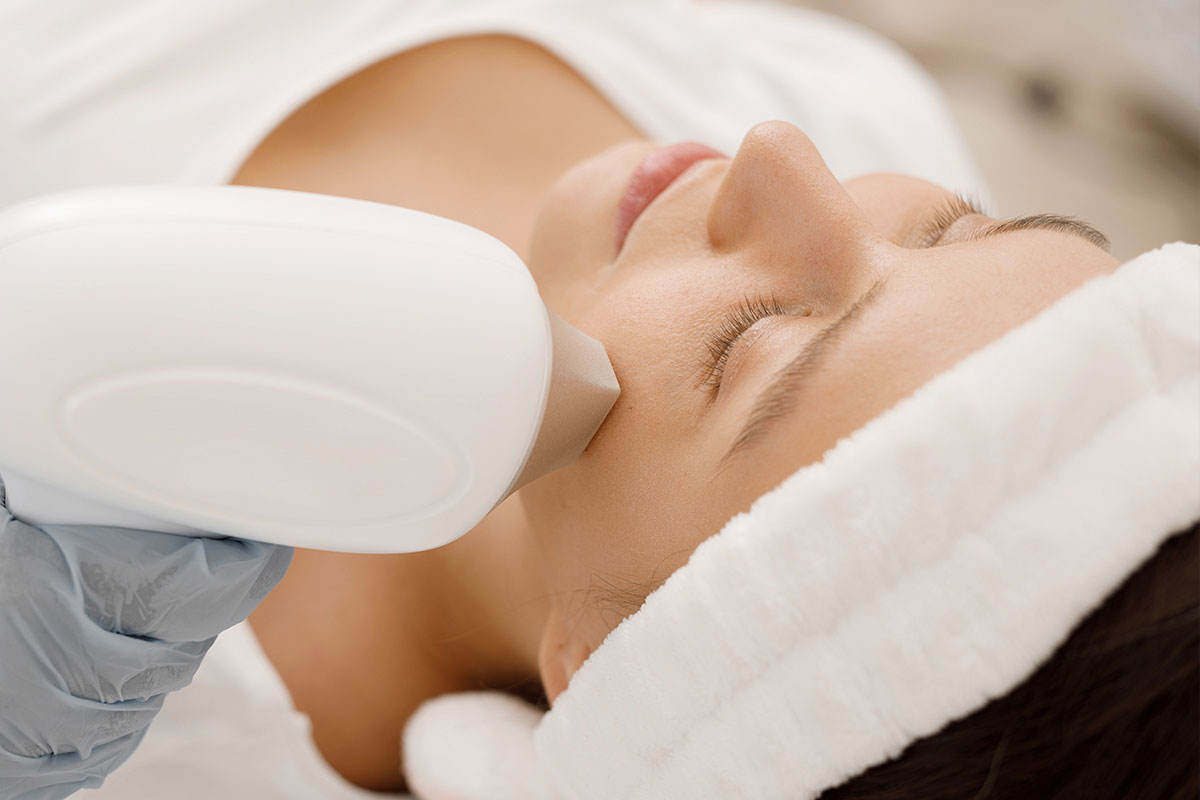Why Current Melasma Treatments Don’t Work and Might Make Your Condition Worse

Of the many conditions that skincare professionals encounter today, one of the most prevalent and mysterious is Melasma. Just ask Charlie’s Angels actress Drew Barrymore – the 46-year-old starlet isn’t shy about her “crazy level 10 Melasma”, and once likened her condition to having “dirt all over my face.”
Sounds like an exaggeration, but for many patients with this condition, it isn’t really. People1 with melasma can refuse to leave home, ruminate ceaselessly about their melasma, and feel inferior to others due to their skin condition. It is therefore not uncommon to hear of individuals feeling depressed, frustrated, and ashamed.
Melasma, which often presents as brownish patches on the cheeks, can appear on other parts of the face, jaw and neck as well, and is brought about by a mixture of genetic, hormonal, and environmental factors. Melasma is very common among Asians, and tends to affect women more than men.
And here’s the kicker: Melasma is a chronic condition that is incurable. But it can be managed — provided you undergo the correct treatments that improve and not worsen your condition.
In this article, allow me to explain why melasma is so difficult to treat, the limitations of pigmentation treatments in Singapore, and why some lasers can worsen your melasma.
The causes of melasma
The crux of the condition involves your skin’s pigment-producing cells, a.k.a2 Melanocytes, becoming overactive and producing way too much melanin. While we don’t have a complete understanding of what exactly makes these cells start behaving in this way, there is strong evidence that the following triggers melasma or pigmentation in general:
- Sun or UV exposure: Melasma is influenced by UV rays, just like sunspots. Those who have melasma may notice that their dark spots appeared or worsened after a period of sun exposure.
- Hormonal changes: This can occur in the form of hormonal imbalances, pregnancy, or the use of oral contraceptives. Pregnancy is famously notorious for causing flare ups of melasma – so much so that the condition has been christened ‘the mask of pregnancy’.
- Other causes: Family history of melasma, hormone replacement therapy, thyroid disease, low testosterone levels, and more.
For some melasma sufferers, the normal rebalancing of hormones after pregnancy can cause ensuing dark spots to fade on its own. This is what we call transient melasma. Unfortunately, for most others, melasma is frustratingly persistent.
Classifications of melasma
Why do some melasma sufferers successfully treat their skin with sunscreen and topical creams, while others struggle hopelessly even with the use of Pico lasers and other costly treatments? Let’s find out:
|
Epidermal melasma |
Dermal melasma |
Mixed melasma |
Vascular melasma |
Melasma islands |
Mottled melasma | |
|
What is it? |
This means that the pigment (melanin) is in the more superficial layers of the skin called the epidermis. |
With Dermal melasma, the pigment is in the deeper layers of the skin, the dermis. |
As a combination of epidermis and dermal melasma, mixed melasma is the most difficult to treat. It occurs with other pigmentation issues like nevus and lentigines. |
Vascular melasma’s calling card is vascular proliferation, or increased vascularity. |
This type of melasma occurs near the eyes. |
This melasma pattern might be due to previous over-lasering resulting in white patches and spots. |
|
Treat- ment |
As this type of melasma is superficial, it usually clears with the regular use of topical creams, sun avoidance, and other similar treatments. |
An effective combination of superficial treatments such as topical creams and sunscreen, plus Secret RF and microneedling are needed. |
While you may get promising results from a chemical peel, they tend to be short-lived. Different laser protocols are needed for various mixed melasma conditions. |
Antivascular pigmentation treatment with the Curas Laser, and vascular treatment with the Proyellow Laser works best for positive outcomes. |
This type of melasma can be hard to manage. It is best treated with Picomax and Secret RF. |
Non-aggressive laser treatment is needed to avoid hypopigmented spots. Aggressive laser energy will only worsen any white spots. Tranexamic acid oral treatment and microneedling with Secret RF will yield good results. |

Why is melasma so difficult to treat?
Laser treatment could worsen melasma
Recurrence rates after successful treatments are reportedly high3, and for more severe cases, chemical peels, IPL therapy, laser treatments and the like tend to offer variable, lackluster, and gloomily short term results.
What many are unaware of is that pigment laser treatment is also known to worsen melasma and produce a risk4 of post-inflammatory hyper or hypopigmentation (PIH). The heat from such technology tends to make melasma worse, and can trigger the formation of even more pigment in the weeks following treatment.
The Q-switched laser: friend or foe?
Some of you might be familiar with Q-switched lasers. These lasers became commercially available in the 90s, and have since grown to be wildly popular in Singapore. Prior to this, dermatologists only used lasers for treating the skin surface, which is why the Q-switch laser is so special: It selectively targets and treats pigmentation within the skin.
While these lasers have successfully helped treat pigmentation disorders such as freckles, solar lentigines, and ABNOM, it is not reliably effective when it comes to managing melasma. Q-switch lasers help break down melanosomes at the bottom of the epidermis, which contain melanin, and does so without any redness, bruising, or downtime.
However, the Q-switch laser does not successfully confront any of the root causes of melasma, which means that melanocytes in the epidermis are still producing lots of melanin, and that frequent relapses, or even a worsening of conditions, is bound to happen.
And while the repetition and quantity of treatments varies across the differing technologies, Q-switched lasers require the greatest number of treatment applications for good results.
Melasma requires a multi-pronged approach
One key point to consider is that while laser treatments can accelerate the removal of melasma-related hyperpigmentation, they are far from cures. The most effective management of difficult melasma cases often includes a combination of technologies and therapies.
As melasma is aggravated by hormones, it’s also not uncommon for dermatologists and gynecologists to work hand in hand to help patients transition to a low-dose pill, or if possible, wean them off the pill entirely.
Melasma is triggered by uncontrollable factors like the sun
Singapore’s never-ending summer is brutally unrelenting, which is why a broad-spectrum sunscreen with a high SPF needs to be a regular part of your skincare regimen. It’s also a good idea to wear a hat with a wide-enough brim that’ll protect melasma hot spots like your nose and cheeks.
While less challenging conditions can be managed with the consistent use of broad spectrum sunscreens, medicated creams, and staying out of the sun, such methods only bring about an initial clearance of the condition, and have zero to little effects for sufferers of more severe cases of melasma.
Limitations of current melasma treatments in Singapore
To summarise, here are some common melasma treatments available in Singapore today:
- Chemical facial peels: This process removes discolored patches and melanin, whilst promoting new skin growth. Chemical facial peels, however, present a risk of post-inflammatory hyperpigmentation, and cannot be used to treat melasma that affects the deeper dermis.
- Lasers: With lasers, a focused beam of light energy is used to heat and destroy pigment in the skin. However, there is a risk of rebound pigmentation. Recurrences are high even with low-energy laser treatments.
- Microneedling: Punctures are made in the epidermis to allow the ingredients in topical creams to penetrate into deeper layers of the skin, where your blood vessels and pigment cells are located. While microneedling has developed exponentially over the years and shows much potential, the use of microneedling on its own is not yet proven to drastically improve melasma.
The inefficacy and variability of these treatments is the reason why Ozhean Zoey utilises a combination of Secret RF and Pico Laser to effectively treat melasma. I will speak about this approach in a separate article.
References
- https://clearifirx.com/blog/melasma-treatments
- https://www.sciencedirect.com/topics/biochemistry-genetics-and-molecular-biology/melanocyte
- https://www.nsc.com.sg/Patient-Guide/Health-Library/Types%2520of%2520Skin%2520Conditions/Pages/Melasma.aspx
- Trivedi, M. K., Yang, F. C., & Cho, B. K. (2017). A review of laser and light therapy in melasma. International journal of women's dermatology, 3(1), 11–20. https://doi.org/10.1016/j.ijwd.2017.01.004






